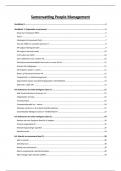Samenvatting
International Strategy Summary
This comprehensive summary encompasses the entirety of weeks 1-7, incorporating concise overviews of all readings, lectures, and knowledge video clips, accompanied by brief definitions for key terms. Concluding the summary is a structured table containing summaries and keywords for each reading, se...
[Meer zien]














